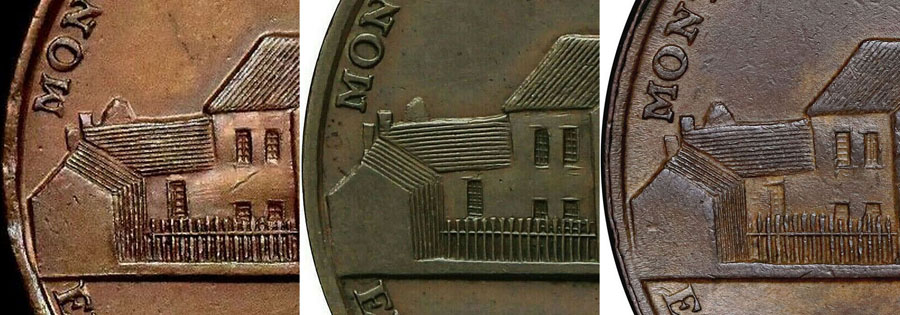
This guide helps to identify varieties of Angusshire Montrose Lunatic Hospital halfpenny token issued by tobacconist Andrew Nicol supposedly in 1799. According R.C.Bell, ten cwts of this token (508 kg) were struck, all varieties combined. One token weights 8.5 g (my own measurement), so total mintage is about 60,000. From the wear of specimens it is clear that these tokens were extensively used as currency.
There are seven varieties listed in D&H, namely Angusshire Nos. 30-36 (page 407). I strictly follow D&H and do not attempt to discover new varieties. This guide is based on my two samples and others found on the Internet. It should be noted that tokens on online auctions are sometimes identified with errors; the descriptions in D&H being far from unambiguous. The token itself is not rare but many specimens are quite worn.
Since some dies are identical across D&H numbers, it is instructive to describe obverse and reverse dies separately. The obverse side is one with a shield of arms and date 1799, the reverse side is one with a building and date 1781 (the date when Hospital was opened).
Warning! The findings presented here cannot be viewed as an absolute truth and may contain errors!
Obverse dies
These are distinguished by the form and position of eagle's tail against a letter H. The descriptions in D&H are rather vague and are wanting to be better illustrated. The illustrations and descriptions indicate that No. 32 and No. 36 have the same obverse.
| Obv. A | The tail of the eagle extends slightly beyond the second limb of H (Nos. 30, 33) One of the eagle wing's feathers touches H. There are ghosts in letters A and P of HALFPENNY. Digit 7 of date does not reach the circle while both 9s touch the circle. 9s have fancy ends. |
| Obv. B | The tail of the eagle to the second limb of H. Terminal of 7 touches circle (No. 31). Rare. |
| Obv. C | The wing and tail further from H (Nos. 32, 36). Eagle's wing is short and is far from H. The tail is beyond the second limb of H. 7 and 9s of date touch circle. |
| Obv. D | The wing and tail close to H (No. 34). Eagle wing is quite close to H (but does not touch it). 7 of date touches the circle; 9s have plain ends (if not obscured by die break). Sometimes die break can be seen going through eagle's head and letters HA of HALFPENNY. Die break under the date is common. |
| Obv. E | The wing and tail further from H (No. 35). Eagle's wing is short; there is some distance between the wing and H. Tail does not extend beyond second limb of H. 7 and 9s of date are plain and all touch the circle. |

Obverse dies A, B, C, D, E.
To distinguish between obverse dies examine the distance between the eagle's wing and tail and the letter H (see illustration above).
Reverse dies
Reverse die classification is based on the position of letter M relative to building's chimneys. Only three reverse dies are described.
| Rev. 1 | M of MONTROSE to the left of first chimney (Nos. 30-32) |
| Rev. 2 | M of MONTROSE nearly over first chimney (No. 33) |
| Rev. 3 | M of MONTROSE nearly touches second chimney (Nos. 34-36) |
From left to right: reverse dies 1, 2, 3 (click the image to see enlarged version). Note the position of a letter M relative to chimneys.
It is easy to distinguish reverse 3: the letter M is close to the second chimney. Reverse 2 has very regular fence posts unlike reverses 1 and 3. Reverse 1 has letter M to the left of chimneys and irregular fence.
Die combinations
Here is a map to convert (Obverse, Reverse) pair into D&H number.
| obv. A | obv. B | obv. C | obv. D | obv. E | |
| rev. 1 | No. 30 | No. 31 | No. 32 | ||
| rev. 2 | No. 33 | No. 31Bis | |||
| rev. 3 | No. 36 | No. 34 | No. 35 | ||
No. 31Bis is not listed in D&H. The sample was seen at the Baldwin's Auction 107 when the Deane's collection was sold.
Did you know?
The arms and motto "Ne oublie" on the obverse belong to the Duke of Montrose. Read about James Graham, 1st Marquess of Montrose and A Legend of Montrose by Sir Walter Scott.
Token edge is specified in D&H as "PAYABLE BY ANDREW NICOL TOBACCONIST", however on the actual tokens the edge has a mistake (TOBACONIST).
Nos. 30 and 31 are listed as rare by D&H; the rest is scarce. Nos. 34 and 35 seem to be most common.
D&H catalogue contains another Montrose token with three varieties (Nos. 27-29).
